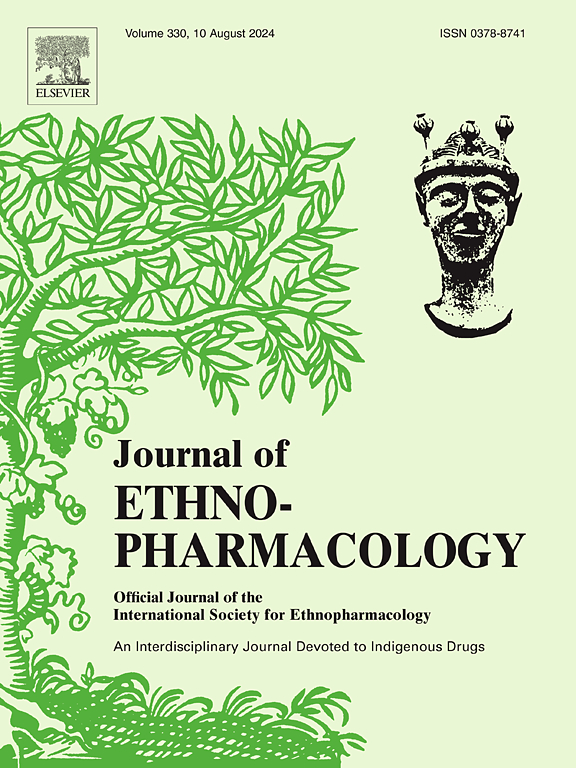Effects of Mume Fructus extract on smoking-induced cough and TNBS-induced colitis in rats and its underlying mechanisms based on gut-lung body fluid metabolism
IF 5.4
2区 医学
Q1 CHEMISTRY, MEDICINAL
引用次数: 0
Abstract
Ethnopharmacological relevance
Mume Fructus (MF) has been widely used in traditional Chinese medicine to alleviate chronic cough, diarrhea, and dysentery. Our previous studies confirmed that MF exerts beneficial effects on 2,4,6-trinitrobenzenesulfonic acid (TNBS)-induced inflammatory bowel disease (IBD) in rats. However, the active components of MF and underlying mechanisms by which it alleviates both cough and colitis remain incompletely understood.
Aim of the study
This study aims to further elucidate the active components of MF and underlying mechanisms for alleviating both cough and colitis.
Materials and methods
UPLC-Q-TOF-MS/MS was used to analyze the chemical profiles of MF ethanol extract and its fractions (MFE0, MFE40, and MFE100). A rat model was established through simultaneous cigarette smoke exposure and TNBS enema administration to evaluate the ameliorative effects of these fractions on both cough and colitis. Molecular docking was combined with western blotting to investigate the underlying mechanisms.
Results
Among the three fractions of MF, MFE40 and MFE100 significantly reduced cough frequency and pulmonary edema, ameliorated colon shortening, and alleviated pathological damage in the lungs and colon of model rats. In contrast, MFE0 showed limited efficacy against cough and pulmonary edema. UPLC-Q-TOF-MS/MS identified key compounds in MFE40 and MFE100—including citric acid derivatives, hydroxycinnamic acid derivatives, flavonoids, unsaturated fatty acids, and terpenoids—which exhibited strong binding affinity to TLR4, AQP5, αENaC, TRPV1, and Na+/K+-ATPase in molecular docking analysis. Western blotting confirmed that MFE40 and MFE100 modulated expression of αENaC, TLR4, AQP5, and AQP3 in lung and colon tissues, suggesting these fractions improve cough and colitis by regulating body fluid metabolism and reducing inflammation.
Conclusion
MFE40 (primarily citric acid and hydroxycinnamic acid derivatives) and MFE100 (mainly flavonoids, unsaturated fatty acids, and terpenoids) alleviated smoking-induced cough and TNBS-induced colitis in rats. These effects are mediated through TLR4 regulation and the activation of AQPs and ENaC, which together regulate body fluid metabolism and mitigate inflammatory injury in the lungs and intestines. This study elucidates the active components and underlying mechanisms of MF in mitigating cough and colitis, providing scientific evidence for the clinical application of MF in managing IBD and its extraintestinal manifestations.

梅子提取物对大鼠吸烟致咳嗽和tnbs致结肠炎的影响及其基于肺-肠体液代谢的机制
民族药理学相关性:梅子(MF)在中药中被广泛用于缓解慢性咳嗽、腹泻和痢疾。我们之前的研究证实了MF对大鼠2,4,6-三硝基苯磺酸(TNBS)诱导的炎症性肠病(IBD)有有益的作用。然而,MF的活性成分及其缓解咳嗽和结肠炎的潜在机制仍不完全清楚。研究目的:本研究旨在进一步阐明MF的有效成分及其缓解咳嗽和结肠炎的潜在机制。材料与方法:采用UPLC-Q-TOF-MS/MS分析了MF乙醇提取物及其组分(MFE0、MFE40和MFE100)的化学特征。通过同时暴露于香烟烟雾和TNBS灌肠建立大鼠模型,以评估这些组分对咳嗽和结肠炎的改善作用。分子对接结合western blotting研究其潜在机制。结果:MF三组分中,MFE40和MFE100均能显著降低模型大鼠咳嗽频率和肺水肿,改善结肠缩短,减轻肺、结肠病理损伤。相比之下,MFE0对咳嗽和肺水肿的疗效有限。UPLC-Q-TOF-MS/MS鉴定出MFE40和mfe100中与TLR4、AQP5、αENaC、TRPV1和Na+/K+- atp酶具有较强结合亲和力的关键化合物,包括柠檬酸衍生物、羟基肉桂酸衍生物、类黄酮、不饱和脂肪酸和萜类化合物。Western blotting证实MFE40和MFE100可调节αENaC、TLR4、AQP5和AQP3在肺和结肠组织中的表达,提示其通过调节体液代谢、减轻炎症来改善咳嗽和结肠炎。结论:MFE40(主要是柠檬酸和羟基肉桂酸衍生物)和MFE100(主要是黄酮类、不饱和脂肪酸和萜类)可减轻大鼠吸烟致咳嗽和tnbs诱导的结肠炎。这些作用是通过TLR4调节和AQPs和ENaC的激活介导的,它们共同调节体液代谢,减轻肺和肠的炎症损伤。本研究阐明了MF减轻咳嗽和结肠炎的有效成分及其作用机制,为MF在IBD及其肠外表现的临床应用提供了科学依据。
本文章由计算机程序翻译,如有差异,请以英文原文为准。
求助全文
约1分钟内获得全文
求助全文
来源期刊

Journal of ethnopharmacology
医学-全科医学与补充医学
CiteScore
10.30
自引率
5.60%
发文量
967
审稿时长
77 days
期刊介绍:
The Journal of Ethnopharmacology is dedicated to the exchange of information and understandings about people''s use of plants, fungi, animals, microorganisms and minerals and their biological and pharmacological effects based on the principles established through international conventions. Early people confronted with illness and disease, discovered a wealth of useful therapeutic agents in the plant and animal kingdoms. The empirical knowledge of these medicinal substances and their toxic potential was passed on by oral tradition and sometimes recorded in herbals and other texts on materia medica. Many valuable drugs of today (e.g., atropine, ephedrine, tubocurarine, digoxin, reserpine) came into use through the study of indigenous remedies. Chemists continue to use plant-derived drugs (e.g., morphine, taxol, physostigmine, quinidine, emetine) as prototypes in their attempts to develop more effective and less toxic medicinals.
 求助内容:
求助内容: 应助结果提醒方式:
应助结果提醒方式:


